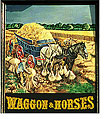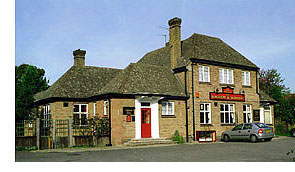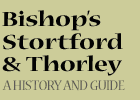|
Foxley Drive was once home to the popular Foxley Hotel, originally built as a private house in 1905 but transformed into a hotel in 1935 and run, at that time, by Alfred Clark. The recession of the 1980s forced its closure and the hotel was demolished in 1994 to make way for private houses.
Just south of Stansted Road’s junction with Parsonage Lane is the former site of Collins Cross railway bridge, built in 1867 to carry the Bishop’s Stortford, Dunmow and Braintree Branch Line across Stansted Road. Parting company with the London to Cambridge main line just north of the town station, the single-track branch line continued in a steep climb to this point where a man-made embankment took it onto the bridge.
To enable traffic to pass beneath it the road had to be lowered substantially, but little attention was paid to drainage and even after minimal rainfall the road would flood, often to depth of 2ft (70cms). Where the bridge stood is indicated on the eastern side of the road by a short stretch of red bricks, flanked by what is left of the original yellow brick buttresses that formed its support.
Once over the bridge the branch line went into a cutting, heading south-east towards Hockerill and then east towards the towns of Dunmow and Braintree. Passenger trains continued to use the line until 1952 and freight services until 1971, but by this time motorised transport had made it unprofitable and the line was finally taken up in 1974 (See Guide 11). The bridge was removed in 1976 and the road at this point widened and levelled to avoid future flooding.
|
|
This road was named as such after a small section of the Roman road Stane Street was discovered here prior to housing development in 1976. Although built shortly after the Romans arrived in the 1st century A.D., the road was still in remarkable condition. Two lanes were apparent – one for horse-drawn traffic and one for foot soldiers – as were its associated 'V' ditches running alongside, used for drainage. Several artifacts found by archaeologists were taken to the local museum, and afterwards a small section of the road was reconstructed using original materials found at the site. It was marked with a commemorative plaque.
Unfortunately, that reconstruction no longer exists. The site originally belonged to J.A. Elliotts Ltd, a former and long established Stortford based building company, whose owner Jock Elliott built his first office here in 1950. The firm grew to become one of the largest building contractors in the south of England, but a rapid downturn of the economy in the late 1980s forced them into liquidation in 1991. When Elliott's offices here were finally demolished in 1999 to make way for the present Elliott Court (named in memory of Jock Elliott), the developers supposedly failed to notice the plaque or section of reconstructed Roman road, and it was lost forever.
|
|
John (Jock) Arthur Elliott was born in 1907 in the village of Hendon, now part of Sunderland in the North East of England. He had two brothers and a sister. Between 1922 and 1925 he was an apprentice shipwright in Sunderland, but had a preference and raw talent for playing football. Such was his desire for the game that on completing his apprenticeship he was told to choose between football and the shipyard. His answer promptly got him the sack and thereafter he pursued a career as a professional footballer.
Family legend has it that he signed to play for Sunderland F.C., but he certainly never made the first team and never discussed the matter. He did, however, play for Durham City in Division 3 (North) as centre forward. In 1928, with the promise of a job in London and the chance to play football for amateur club Crystal Palace, he moved south. He also possibly played for Wimbledon, but between matches worked as a carpenter and joiner for London building firm, Moss.
Work contracts took him to jobs near Bishop's Stortford and Saffron Walden where he often played football for the teams of both towns. At Stortford his prodigious talent was soon spotted by club president George Wilson, who quickly signed him up. He also arranged a job for Jock, his first task being to erect a fence in Dunmow Road. Although without a trade, as such, Jock was a hard and conscientious worker. In the mid 1930s he devised an efficient way of putting up ceilings, earning himself considerably more per week than the average tradesman at that time, and quickly built up a small business. The name 'Jock' was apparently given to him by the people of Bishop's Stortford. Having difficulty understanding his Geordie accent, they figured he was from so far north that he must be Scottish.
His football was all important though. He soon became one of the club's top goal scorers, as well as team captain and trainer, but in 1937 left to play for Saffron Walden. That same decade Jock married Nellie Graham, whom he met in London, and between them they produced two sons, Chris and Maurice. Having saved all the money he earned, he built two houses in 1938 – Nos 24 and 26 Thorley Hill – then moved into No 24 with his family. When war came the following year he twice volunteered for service, but his building experience put him in the 'reserved occupation' category. He helped with many building projects allied to this country's defence, and was later put in charge of building facilities for the USAF at Stansted and Wethersfield. When the threat of invasion passed he was deployed to Norwich repairing bomb damage regularly inflicted by the Luftwaffe.
At the start of the war, Jock and Nellie fostered one of the thousands of children evacuated from London to the relative safety of the countryside. The child's name was Derek Jameson. When he left the Elliott's home to join Reuters news agency as a messenger boy around 1943/44, aged 14, he made a promise to return when he'd made a success of himself. This Jameson did in 1979 after being appointed Editor of the Daily Express.
In 1946 Jock started his own building company from the front room of his house at Thorley Hill. He also returned to football; this time as Bishop's Stortford's team manager for the 1946/47 season. In January 1948 his business became a limited company – J.A. Elliott Ltd – and in 1950 he built his first office on the Stansted Road (now the site of Elliott Court). Early contracts included building new houses and extensions, but as the firm expanded the contracts got bigger. Locally, these included the very first terminals at Stansted airport, the Charringtons and EHDC offices at Causeway, and Margaret Dane (Girls) School (now Birchwood High School). In London contracts included the National Theatrical Museum, the cobbled piazza and London Transport Museum at Covent Garden, and an extension to the V&A Museum.
Jock Elliott was a bull of a man who bore a striking resemblance to the former Russian president, Nikita Kruschev. Under his energetic, albeit abrasive, leadership the company thrived, yet he still found time for his beloved football. After a disappointing 1952/53 season, Bishop's Stortford's F.C. invited Jock to manage the team again. He guided them to a respectable position in the Delphian league in 1953/54, but in 1954/55 he more than fulfilled expectation. The team lost only three games all season and won the Delphian League trophy. They also won the Herts Charity Shield and were beaten finalists in the Herts Senior league. The reserve team won the Aubrey Cup. Sadly, for the club, increasing work commitments forced Jock to stand down at the end of the season.
He did, however, still find time for the odd round of golf and a game of bowls. The latter was something else he was exceptionally good at and in 1950 he played a leading role in forming East Herts Bowling Association. Despite his wealth, Jock never forgot the poverty of his childhood in Sunderland. Early on in life he had struck up a friendship with the artist L.S. Lowry (1887–1976) and even helped him out financially at a time when he was struggling to make ends meet. This was not something Jock ever spoke of but his patronage is referred to in Lowry's biography. Perhaps to repay the favour, in the 1960s Lowry offered Jock one of his canvasses for a very reasonable price. But Jock, always careful with money, turned down the offer. He already had two Lowry reproductions on his sitting room wall and later commented 'Why would I need the original when I could get two reproductions for the same price.'
In 1966 Jock handed over the reins of the business to his sons Chris and Maurice, then retired to Gresham in Norfolk. There he filled his time by playing golf and bowls but sorely missed the building industry and within ten years moved back to Bishop's Stortford. By this time the offices at 133 Stansted Road had been expanded and refurbished, and the joinery yard at the rear of the building was in the throws of being moved to nearby Start Hill. The site was then replaced by a new housing development called Legions Way.
Elliott's corporate HQ remained at Stansted Road, but in 1979 the firm siezed the opportunity to buy Twyford House and Twyford Mill, inclusive of 10 acres of land and river-frontage (See Thorley Guide). Previous apartments there were refurbished and new accommodation built to finance the renovation and refurbishment of Twyford House itself. Completed in 1986, the firm then moved their corporate HQ from Stansted Road to Twyford House
Between 1978 and 1990, J.A. Elliotts Ltd became one of the south of England's most successful companies, employing over 500 people. But the recession of 1987 and a downturn in the economy in 1990, particularly in the building industry, hit the firm hard. A £3m bank loan secured their future in the short-term, but as the situation worsened the bank withdrew support and J.A. Elliotts Ltd went into receivership on Valentines Day 1991.
But by this time Jock Elliott was in the early stages of Alzheimer's Disease and had little understanding of what was happening to the company he started way back in 1946. As his condition worsened he was moved to the Herts & Essex hospital, but soon became a shadow of the man he once was. His wife Nellie lived without him for two years and died 21 February 1994, aged 82. Jock died in Herts & Essex hospital on 8 September 1995, aged 88. Both are buried in the cemetery at St James the Great, Thorley.
My thanks to Jon Elliott for additional information regarding Jock Elliott. A book 'Elliotts Bishop's Stortford and Beyond' by Chris and Maurice Elliott, is available in local book stores.
|
|
  Sadly the Waggon and Horses is no more. Closing for good on 18 August 2007 the site is currently up for sale and will no doubt be bought for yet more property development. Sadly the Waggon and Horses is no more. Closing for good on 18 August 2007 the site is currently up for sale and will no doubt be bought for yet more property development.
The original pub on this site, going by the same name and standing much closer to the road, is said to have stood for almost 300 years. It was kept in in 1851 by James Newton, hay cutter, and later by various members of the Potter family. The later pub, built by former local builders JA Elliott & Sons, was unique in Stortford because it was designed by a woman – a Mrs Cotton. And it was another woman Mrs EM Smith, Chairman of the Stortford bench, who drew the first pint when it opened in May 1957.
A managed house until 1967 it was first taken over by Ind Coope, then by Punch Taverns who sold it as part of a package deal of 869 pubs to Admiral Tavens in April 2007. But their tenure was brief. Despite the addition of a small motel next to the pub in 2004/5, which has also closed, falling trade made the pub uneconomical to run.
|





 Sadly the Waggon and Horses is no more. Closing for good on 18 August 2007 the site is currently up for sale and will no doubt be bought for yet more property development.
Sadly the Waggon and Horses is no more. Closing for good on 18 August 2007 the site is currently up for sale and will no doubt be bought for yet more property development.